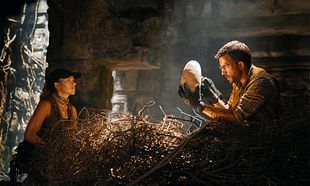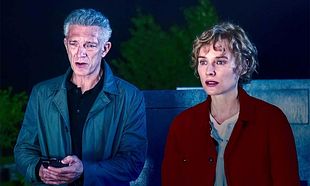Roy Andersson follows up 2007’s You, The Living with this philosophical oddity that is funny, poignant, insightful and depressing. Mostly depressing.
Andersson takes the viewer through a series of vignettes (thirty-nine in all) that indirectly address some philosophical musings. It’s all here: history, heartbreak, sexism, capitalism, memory, friendship, love, life, old age, death. All delivered with a dry, deadpan sense of humour. There’s the husband who suffers a heart attack opening a bottle of wine as his wife hums a song in the kitchen; an old man remembers the waitress who offered shots in return for a kiss; a dance teacher makes advances on her troubled student; a former sailor awaits a rendezvous when it dawns on him that he might have the time wrong. And the location. And the date. Patrons of a café are disturbed by the army of Charles XII making the disastrous march on Russia. Siblings bicker with a dying mother over her belief that she can bring her treasured handbag to heaven.
Andersson returns to two characters whose story forms the backbone of these loosely connected shorts. Jonathan (Andersson) and Sam (Westblom) are two down-on-their-luck salesmen hawking joke shop paraphernalia (masks, laughing bags, vampire teeth). Determined to ‘help make people laugh’ despite their dour expressions, their amateurish efforts fall short of success and soon financial pressure has the two friends turn on each other.
The first scene sets the tone. A man wanders about a room in museum inspecting the stuffed birds behind glass cases while his impatient wife waits with shopping bags by the door. He is taken aback by the third case he didn’t see: a pigeon sits on a branch gazing back at him. But it’s not what happens in the scene that grabs the attention, it’s the style. Using a single static shot here, and for every vignette thereafter, the characters come to resemble humans in a glass case, stuffed and mounted in awkward stances, and the audience are the gawkers on the other side captivated by this thing called humanity. The dialogue is on message, deliberately stilted and delivered flat. The colours catch the eye too. Greys, creams and browns not only dominate the sets but also the suits and the skins of the characters, giving the film a pasty air of unhappiness and despair. But still funny, mind.
An original work.











































































